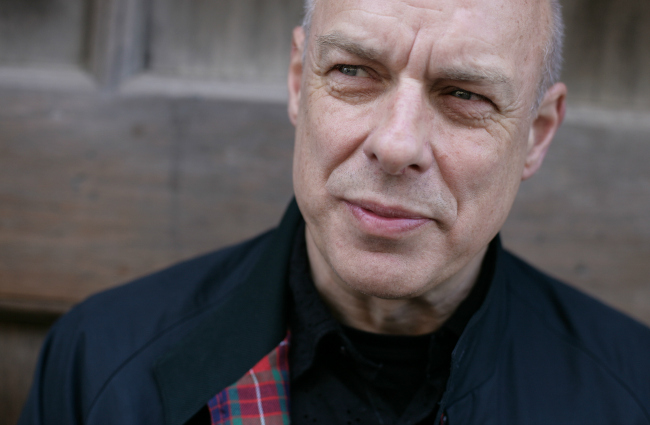
In 2010, on their underrated second album Congratulations, MGMT paid homage to Brian Eno on a track named, well, “Brian Eno.” In the song’s opening line, they talking about following music to a cathedral, and finding out Eno had produced the music they were hearing. It was a fitting tribute to one of the most important musicians and producers in the history of modern music. Chances are, even if you’ve never heard of Eno, who has a new album, The Ship, out this week, you’ve listened to plenty of music that has been either produced by him, or heavily influenced by him.
Eno began his career with the English glam rock group Roxy Music, where he would play keyboards on their first two albums, Roxy Music and For Her Pleasure. His playing was a big part in the band’s mixture of glam rock bravado and atmospherics. When he left the band in 1974, they continued to make great music, but their approach was far more straightforward, as Eno’s experimental touch was no longer part of the sound.
After going solo, Eno released two glam-inspired albums, Here Come the Warm Jets and Taking Tiger Mountain (By Strategy). Both albums were gloriously weird and brilliant, but Eno was just beginning to see how far he could stretch the conventions of popular music. That would really start to happen in 1975, when he released Another Green World, an album that would essentially bridge the gap between rock music and what we now know as ambient. Several of the tracks were instrumental, and even those with vocals were both atmospheric and hypnotic. On “I’ll Come Running,” the chant of “I’ll come running to tie your shoe” blends in with the rest of the music. This was where Eno really began to show what he was capable of, and where he would go next would revolutionize music.
Eno is often considered the father of ambient music, and the album that really earned him that reputation was 1978’s Music for Airports. The album consisted of four sparse tracks, and was essentially intended to blend into the atmosphere of wherever it was being played. True to its name, it actually was played at New York’s LaGuardia Airport in the early 1980s. This was the album that officially made ambient music a thing, but throughout his career, Eno made several other albums that would come to define the genre.
One of Eno’s most impressive — and best known — ambient works is 1983’s Apollo: Soundtracks and Stories. This was a soundtrack album originally made for a film about the Apollo missions to the moon. The movie was eventually re-titled For All Mankind, and would use some of the tracks from the album. Really, though, the album has taken on a life independent from the film, and it’s one of most beautiful albums. The song “An Ending (Ascent)” in particular, is indicative of what Eno was able to create within the ambient realm.
While Eno made plenty of his albums that have been influential, and hold up extremely well today, he is perhaps best known as a producer. Many people believe he produced on David Bowie’s “Berlin Trilogy” (Low, Lodger and “Heroes”), but that’s actually not the case. While Eno did collaborate with Bowie on those albums, he did not produce any of them. The only album he produced for Bowie was 1995’s Outside, an underrated album that sadly didn’t receive much attention during its release.
That being said, Eno has produced a ton of incredibly influential albums. He is probably best known for his work with U2, where he produced albums like The Unforgettable Fire, The Joshua Tree, Achtung Baby, Zooropa, and All That You Can’t Leave Behind. One of the signature aspects of Eno’s production is the big, booming sounds he creates. You can hear that throughout his work with U2, on tracks like “Pride (In the Name of Love),” and “Beautiful Day.” Big, soaring anthems have always been a major part of U2’s wheelhouse, and Eno was the perfect person to bring them to life.
Younger generations might best know Eno for his work with Coldplay. He produced 2008’s Viva La Vida or Death and All His Friends and 2011’s Mylo Xyloto. Looking at Eno’s work with Coldplay, we can see the two key elements of Eno’s production: brilliant atmospherics, and epic grandiosity. Tracks like “Cemeteries of London” and “Us Against the World” benefit from a subtle approach, while anthems like “Viva La Vida” and “Paradise” are given the bombast and gravitas the need to bring the point across. Since working with Eno, Coldplay scaled back their sound for Ghost Stories and A Head Full of Dreams. Still, it’s hard not to feel like Eno was able to get the most out of their sound.
Throughout over four decades, Brian Eno has both made plenty of brilliant albums as a solo artist, and produced albums for some of the most important artists for the era. When looking at how he was able to develop Talking Heads sound on Remain in Light, or what he was able to create on his own with albums like Before and After Science, it’s all-too-clear that Brian Eno is one of the most important figures in modern music. If you’ve never listened to his work outside of the most famous albums he’s produced, there’s a massive, expansive world waiting for you.






